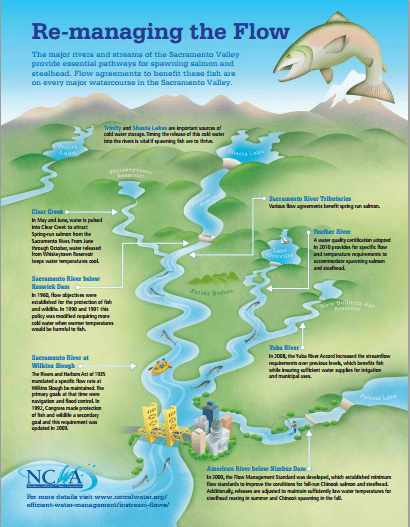by: David Guy
President
Northern California Water Association
The four consecutive years of drought have led to some pundits suggesting that the California water rights system does not work. In fact, the current system for water rights has worked amazingly well during this challenging dry period. Not perfect, but surprisingly well. Yes, there have been significant reductions in water supplies throughout both rural and urban areas in California, which you would expect in dry years and is the way the water rights system is designed to work.
The water rights system is an important foundation for our state and the implementation of the water rights system is essential to economic, social and environmental stability and sustainability throughout California. In February this year, a coalition of water suppliers from every part of the the state—including Southern California, the Bay Area, the Central Valley (the Sacramento, San Joaquin and Tulare Lake portions) and the Central Coast—urged the State Water Board “to uphold and enforce California’s long-established water rights priority system, including its protections for stored water supplies.” The letter stated that “the California water rights system is orderly, well-established, tested and is intended to protect water rights, including previously stored water. The water rights system is particularly important for managing water supplies during drought periods because it provides a known and well established legal framework, administers water resources in an orderly manner, and protects public trust resources.” Specifically with respect to public trust resources, water throughout the Sacramento Valley has been re-managed in very creative ways over the past several decades for the benefit of salmon and birds using the Pacific Flyway.

More specifically, the letter adds that “this past year revealed the tremendous value of stored water for all beneficial uses. As we move into 2015, it is critical that the Water Board take action to 1) maximize the opportunities for project operators to store water early in the year for use later in the year; and 2) administer the priority system and protect storage releases from diversion by those not entitled to the water to assure that all diverters are diverting consistent with the water rights priority system.”
All project water supplies in California have already been reduced due to a lack of water in storage this year. In the Sacramento Valley, these significant reductions are described in Managing Water in the Sacramento Valley for Multiple Benefits in 2015. In other parts of the state, the State Water Project is providing 20 percent of its supplies and the allocations for Central Valley Project water service contracts are currently zero.
Over the next several months, the State Water Board will continue to implement the water rights system by issuing curtailments, based on water rights priorities and an increasingly sophisticated water availability analysis that triggers the curtailments for certain priorities. This means that water right holders must cease using surface water, unless they have either a right or contract to water that is already in storage for this year, or they buy water from another water right holder with rights to water this year. In many places, water users have access to groundwater and they will pump groundwater to make up for unavailable surface supplies.
Although many people suffer from not being able to use surface water—they should not be surprised to receive a curtailment notice in dry years like 2015, as the process generally works in an orderly manner. Importantly, there is also a process for the State Water Board to enforce against illegal users of water, which can be assisted by a complaint process where water right holders can bring illegal uses of water to the attention of the SWRCB.
Click here to view the full copy of the letter.



